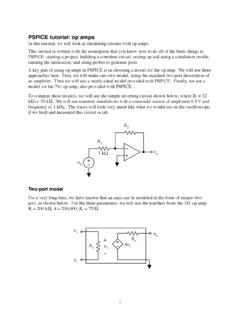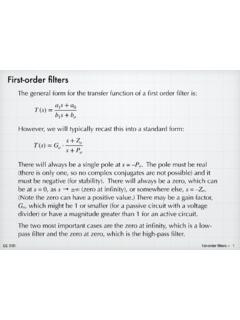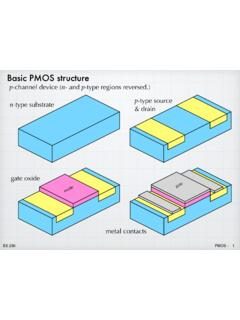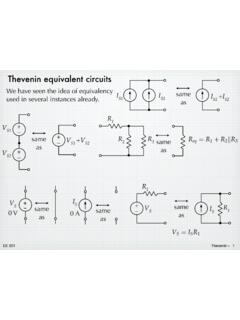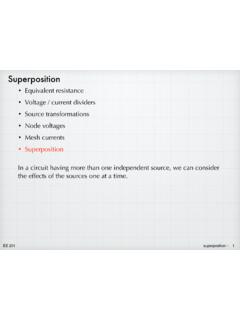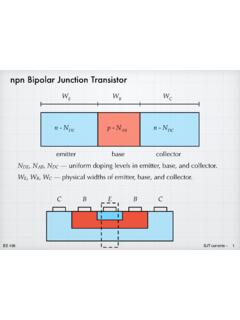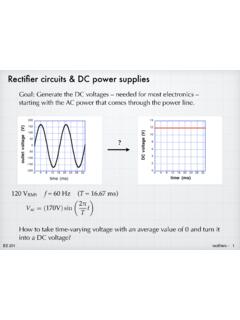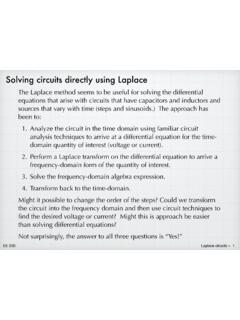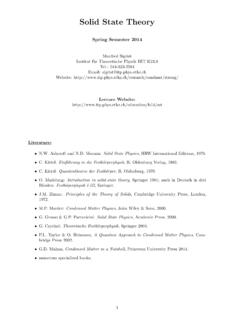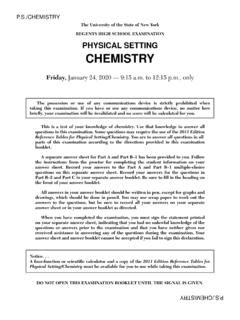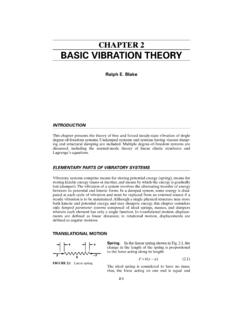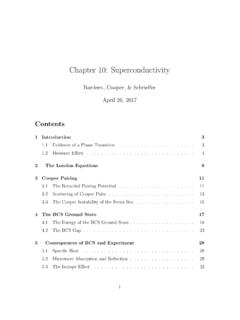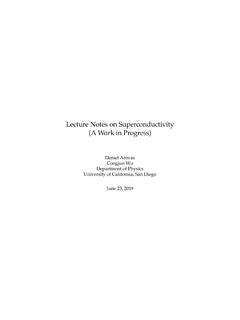Transcription of Diffusion of dopants in silicon - Iowa State University
1 EE 432/532diffusion 1 Diffusion shows up in a number of different circumstances:: Heat through a solid material Odors traveling through the air Tea moving from a tea bag into the surrounding hot water An ink stain moving through a piece of cloth Injected electrons or holes diffusing from the edge of depletion region in the neutral regions of a p-n diode Impurity atoms moving in a semiconductor latticeDiffusion is the smoothing out that occurs in any situation where a high concentration of particles exists in one place and the particles can undergo random motion. The natural tendency is for particles to move towards regions of lower of dopants in siliconEE 432/532diffusion 2 Basically, Fick s law states that if particles in some collection can move ( D 0), they will move in a way that tends to even out the idea of particle movement created by non-uniformities can be expressed mathematically in the form of Fick s First Law, which relates particle flux to concentration gradients:where D is the Diffusion coefficient or diffusivity, with units of m2/s (or cm2/s).
2 Fick s lawF= ' 1 [EE 432/532diffusion 3To get to the Diffusion equation, we must combine Fick s law with a basic continuity a rectangular volume as shown above. Suppose that particles are moving through the box as indicated by the incoming and outgoing fluxes. If the concentration of particles within the box is changing with time, it must happen because there is a difference in the fluxes coming in and going + xflux influx outLyLzContinuity relationN - concentration of particlesN(LyLz x) - number of particles in the box N - change in concentration within a given time t N(LyLz x) - change in number of particles in the box in the time span 432/532diffusion 4If particles are not created or destroyed within the box, then any change in the number must be due to particles moving in and out. If the flux in is higher than the flux out, then number inside increases.]
3 If the flux outward is higher than the flux inward, then the number inside of particles entering the box at x within the time span tnumber of particles leaving the box at x+ x within the time span tKeeping track of the change in the concentration in the box, "N, during some time interval "t: 1/\/] [=F([)/\/] W F([+ [)/\/] W=F([)/\/] W=F([+ [)/\/] WEE 432/532diffusion 5 This type of continuity relation shows up in many different physical situations besides particle Diffusion , including heat flow, electromagnetics and quantum then taking the limit, we obtain the continuity relationRearranging 1 W= F([+ [) F([) [ 1 W= F [EE 432/532diffusion 6 This is the general Diffusion equation. It is a partial differential equation for N(x,t). To find a particular solution, we will need to specify an initial condition, N(x,t=0), and two boundary conditions like N(x=0, t) and N(x=5 m, t), for above form of the Diffusion equation is the most general, allowing for the possibility that D is a function of position.]]]]]]]
4 (D may be a function of position implicitly by being a function of concentration explicitly.) Of course, we also expect D to have an Arrhenius-type dependence on Fick s first equation into the continuity relation, we obtain Fick s second law:Fick s second law - the Diffusion equation 1 W= [ ' 1 [ EE 432/532diffusion 7If we assume that D does not depend on position, then we can write a slightly simpler form of the Diffusion equation:There are relatively straight-forward analytic solutions to the simpler form of the Diffusion equation. However, we must note that the approximation used that D is not a function of concentration is not always valid. If so, then the analytic solutions obtained from the above equation may not even be good approximations. Some of the dopants that diffuse in silicon do not fall into the simple category.]]
5 For example, boron can described reasonably well with the simple theory, but phosphorus , we should note the Diffusion can occur in all three dimensions, so the general 3-D form of the simple Diffusion eq. is 1 W=' 1 [ 1 W=' 1EE 432/532diffusion 8 The general approach to using Diffusion for getting dopants into a semiconductor crystal is to introduce a large amount of the dopant material at the surface of a wafer (create a concentration gradient) and then turn up the temperature (increase D to a reasonable value) and let nature take its can treat the problem in a 1-D fashion. Also, we generally assume that initially there is no dopant within the bulk of the wafer [ N(x 0, t=0) = 0] and the wafer is so thick that no dopant will ever diffuse to the back surface ( that the wafer is effectively infinitely thick).]
6 X = 0xSimplified geometryEE 432/532diffusion 9 One particular instance of this basic approach is the constant-source Diffusion , in which a source of the dopant is applied to the surface and we assume that this has the effect of holding the surface concentration at some high, constant value. The initial and boundary conditions are:The solution to the simple Diffusion equation with these conditions is in the form of the error function, which is well known in the field of statistics, but it is a bit unwieldy.(surface concentration is held constant)(no dopant in the wafer before the Diffusion )(nothing gets to backside)Constant-source diffusion1([> ,W= )= 1([= ,W)=1V1([ ,W)= 1([,W)=1V HUI [ 'W EE 432/532diffusion 10 HUI(X)= X exp Y GYThe error function is the integral of a gaussian. As such, there is no simple form of the expression,We are forced to deal with the messiness of the integral form.]]]]]
7 Generally, we use a table of values or numerical means. (Excel or Matlab both can be used to calculate values for erf(u). Note that erf(0) = 0 and erf(1) = 1, so we use these that the error function does satisfy the boundary conditions of the constant source of an erf-function that the plot is semi-log, as is the custom with the dependent variable ranges over several orders of 432/532diffusion (cm 3)x ( m)Dt3 = 2Dt2 = 4Dt1No = 1020 cm 3 The quantity Dt determines the shape of the profile. The units of Dt are m2. (Dt)1/2 has dimension of length, and it represents the characteristic scale of the Diffusion . If (Dt)1/2 is small, the Diffusion is shallow, and if (Dt)1/2 is big the Diffusion is course, (Dt)1/2 is determined by the temperature and time of the Diffusion . So a Diffusion can be characterized in terms of a time and a 432/532diffusion 12 DoseClearly, the units of dose are m 2 (or cm 2 or m 2 ,etc.))
8 Physically, it means that, if you mapped out a square on the surface of the wafer and then stood within the square on the surface and looked down, the dose would represent all of the dopant that you could see below your feet and within the square, irrespective of distance from the , the dose of a constant-source Diffusion has a simple analytic form, even though the error function itself is can define a quantity called the dose, which is the total amount of a dopant diffused into a wafer. Mathematically,4= 1([)G[4= 1V HUI [ 'W G[= 1V 'WEE 432/532diffusion 13 solid -solubility limitIn principle, the surface concentration that shows up in the Diffusion expression could be controlled by changing the flow of a gaseous source of the dopant. (More about this later.)In practice, however, Ns will be determined by the solid solubility limit of the dopant in the silicon .]]]]
9 This is the thermodynamic limit of the amount of dopant that can be held by the silicon . Trying to shove in more dopant would require a phase change of some sort. This approach works because we use a process that deposits a glassy layer of dopant on the surface of the wafer. The glassy layer provides an essentially infinite source of dopant available for Diffusion . This is how we will do Diffusion in EE 432/532 some of the dopants , the amount of electrically active dopant is less than the solubility limit. For example, at 1000 C, the solubility limit of As is about 1021 cm 3. However, less than half (about 4x 1020 cm 3 of the available As donors are providing free 432/532diffusion 14800 C900 C1000 C1100 C1200 values in cm 3.(Values taken from silicon VLSI Technology by Plummer, Deal, & Griffin, Fig.))
10 7-4, page 376.) solid -solubility limits in siliconEE 432/532diffusion 15A second important Diffusion configuration is the constant-dose Diffusion . As the name implies, a constant dose of dopant is introduced into the semiconductor from some source. The source is removed and then Diffusion proceeds with a fixed amount of dopant available. Generally, we assume that initial dose is located exactly at the surface of the other boundary condition and the initial condition are identical to the constant-source case:The constant-dose boundary condition is(no dopant in the wafer prior to Diffusion )(nothing gets to backside)Constant-dose diffusion1([> ,W= )= 1([ ,W)= 4= 1([)G[=FRQVWDQWEE 432/532diffusion 16 Since there is a fixed dose of dopant, as more atoms move deeper into the wafer, the surface concentration must decrease.]]]]
